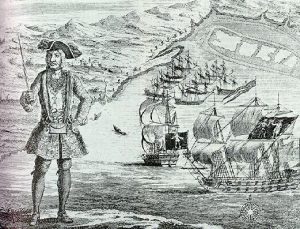
Bartholomew Roberts with his ship and captured merchant ships in the background. A copper engraving from ‘A History of the Pyrates’ by Captain Charles Johnson c. 1724
International Symposium, FAU Erlangen-Nürnberg & University of Bielefeld
Bielefeld University (Germany), 13-14 April 2018
Inspired by this development we suggest a comprehensive approach in literary and cultural studies as well as in history, which looks at the connection between pirates and other seafarers who navigate the North Sea, the Mediterranean Sea and the Atlantic in the early modern period and the cultural products they inspire. Such an approach not only includes a transatlantic perspective, it also allows us to revisit the literary negotiation of piracy by focusing on different aspects like the appearance of piratical protagonists in diverse geographical locations, changing negotiations of pirate identity, and the fluid boundary between illegal piracy and state-sanctioned privateering. With this symposium, we want to establish a dialogue between scholars working on diverse topics connected with literary, cultural and historical representations of piracy and seafaring. In this way, we want to explore the cultural as well as the ideological impact and function of the pirate figure in early modern popular culture.
Papers could focus on (but are not limited to) topics such as:
- regional, national and transnational aspects of piracy
- representations of pirates across different genres
- piracy and gender: viragoes, damsels in distress, and (hyper)masculinity
- maritime law: legal aspects of piracy and privateering
- heroes and villains: the pirate as a criminal and rebel
- piracy, adventure, and popular entertainment
- the relationship between piracy and privateering
- Muslim corsairs in the English imagination
- Caribbean buccaneers and the formation of Empire
- piracy and early modern politics
If you are interested in contributing, please send a brief abstract (max. 300 words) for a 30-minute paper to the organizers by August 09, 2017:
Dr Susanne Gruss (FAU Erlangen-Nürnberg): susanne.gruss@fau.de
Dr Marcus Hartner (Universität Bielefeld): marcus.hartner@uni-bielefeld.de
For further details contact: susanne.gruss@fau.de










Comments are closed.